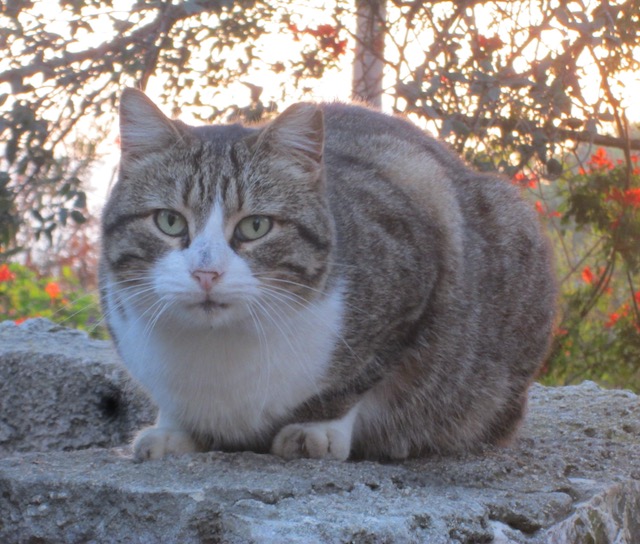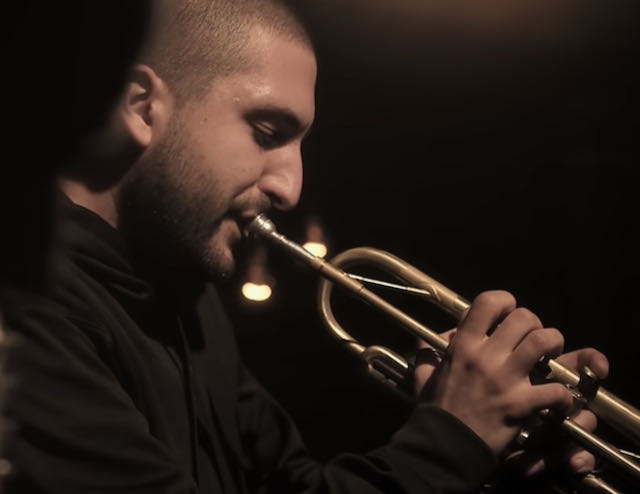 |
| Crusader Altar. Taken on Dec. 28, 2021 (click to enlarge) |
During the holiday season last year we had the chance to go on a very professional archaeological tour of the Church of the Holy Sepulchre. It was intended for licensed tour guides, but they let us in anyway. We learned a number of things we hadn’t even imagined were knowable, so many I can’t even try to mention more than a few. This isn’t so surprising if you stop to think just how much there is to know about a place like this one, continually steeping in history for over two thousand years. It’s true, there is no way anybody can ever know enough about it. Our guide/lecturer was a giant in the field of art history, a teacher at the Hebrew University, Anastasia Keshman. I’d recommend her for any kind of tour if you can succeed in signing up for one.*
(*Please don't imagine I get any benefit out of mentioning her name. I don't do anything like that, ever. Scoff if you like, but it's true.)
At the time I took the picture you see above we were told that it hadn't even been published yet. But by now several news agencies have in fact published pictures of it (you can see some in the links below).
What it is is this: the front face of the altar that was made in Crusader times, and very likely still in use until the famous fire of 1808 damaged it. Then it was slid back into a corner only to be brought out again during the very recent major renovation project. Their reports will contain a lot of interesting new findings, no doubt. The last I was there the archaeologists were busy with their high tech machinery, as they are even now according to my latest information (the project will continue through 2023).
After the fire of 1808, the Greeks received sole authorization to oversee the restoration. It is to a time soon after that the walls around the Catholicon probably date. Before then there were pillars, of course, but no walls to obstruct the view. That means a pilgrim visiting the central area where the altar once stood could have stood on the very spot where the omphalos (the Greek for ‘navel’), the “center of the world,” is still pointed out to pilgrims (this omphalos is mentioned in very early pilgrim accounts).
From that vantage point pilgrims could have turned themselves around in a complete circle and seen all the significant holy sites to be found there, with the one exception of the place of the finding (“Inventio”) of the cross by Empress Helena that is anyway on a much lower level. In direct line of sight, turning toward the right, were Calvary, the Anointment Stone, the Sepulchre, the Flagellation Pillar, the Prison, and finally the doorway leading to stairways down to the place of the Inventio. Oh, and in earlier centuries, before the fire, you could have also seen the tombs of the Crusader kings there at the foot of Calvary. Hardly any trace of them can be seen in the church today. It’s as if they were never there.
The side of that Crusader stone slab with the spiral designs remained for centuries hidden away, while its uncarved backside got covered with graffiti, mostly about who is in love with whom, or So-and-so was here.
At this very moment there is an Italian project to repair and restore the pavement in the entire church complex. This also includes archaeological examination of the layers beneath the stones. You can read about that here:
https://www.biblicalarchaeology.org/daily/biblical-sites-places/jerusalem/restoring_the_holy_sepulchre/
PS (Oct. 31, 2022)
It’s possible to find other examples of altars with front-facing stone slabs that display spiral motifs. There’s one on the island of Malta at the Tarxien Temples, said to date to 3150 BC, so hardly likely as a direct inspiration to the Crusaders. I’m wondering how much the Crusaders made use of Malta. This page may have some answers. But were the spiral motifs visible to them or under the ground?
Look here for a photo.
It seems the ancient Maltese island people had a liking for spirals, and used them in other places, not just on altars. Look at this photo for example.
PSS (December 19, 2022)
I suppose it is too far-fetched to think that Crusaders would have caught a glance of spirals in ancient ruins in Malta before copying them in Jerusalem. I’ve just watched a video about the English coronation throne and the Stone of Scone. I was surprised to see part of it is about the floor in Westminster Abbey where the coronation throne of the English Monarchy was located. It has some very similar aspects. The central inset onyx stone is supposed to represent the earth, with the heavenly bodies arrayed around it. Jungians are bound to see in it a kind of mandala, but I’m not so fast to fix on that idea. Not every circular design can be called by that name.
Although more elaborate, obviously, it has a sufficiently similar layout (one being within a rectangle, the other within a square) with its array of four smaller circular elements that spin off from the central circle in the same spiraling manner. I hope you can see for yourself. And the two mosaics may not be divided by too many years, since the Westminster floor is said to be original to the reign of King Edward I (i.e. 1272-1307). Edward joined the Ninth Crusade, departed for Jerusalem in 1270 and was coronated upon his return to England.
 |
The central design of the floor area called the Sacrarium,
directly in front of the main altar in Westminster Abbey |
An article by Steinmeyer lets it drop that the Crusader altar is in “Cosmatesque” style. That means it was made in the style of an Italian workshop belonging to the Cosmati family. The Cosmatis were in fact the very ones who made the mosaic work in the Sacrarium of Westminster Abbey, not just the pavement, but the area of the wall where the altar is.* So we come full circle even as the argument tightens.
(*Another mind-blowing example of a Cosmati floor may be seen in the Vatican, just look here. Yet another, even closer to the Jerusalem altar stone can be seen at the Santa Maria Maggiore basilica in Rome. For a more general discussion of the Cosmati or Cosmatesque style, look at this Wikiwand.)
- The Coronation Chair and the Stone of Scone is also the name of a book. I'll have to look that one up when I get a chance.
Articles to read:
S. Rees Jones, “The Coronation Chair,” Studies in Conservation, vol. 1, no. 3 (April 1954), pp. 103-114. The chair was ordered to be made in 1299. This article is based on restorations done in the crypt prior to the coronation of Queen Elizabeth II in 1953. These restorations afforded an opportunity to do microscopic and x-ray analysis of the paint and other coverings applied over the centuries.
Jasmine Liu, “Ancient Altar of Holy Sepulchre Church Found, Graffitied Over for Years,” posted on April 21, 2022, at Hyperallergic website. Look here.
Nathan Steinmeyer, “The Ancient Altar from Jerusalem’s Church of the Holy Sepulchre: Excavations Uncover Church’s Original Medieval Altar,” posted by Bible History Daily on April 22, 2022, with link to a video featuring Amit Re'em, only 2 minutes and worth seeing.
“The ancient altar was designed in the “cosmatesque” style, which reflects a combination of classical, Byzantine, and early Islamic traditions. Although the slab has suffered greatly over the years, it originally featured finely worked and colorful marble tiles with detailed engravings. “You cannot see it now, but originally it was inlaid with pieces of precious marble, pieces of glass, pieces of small, finely made marble,” said Amit Re’em, Jerusalem regional archaeologist for the Israel Antiquities Authority, in an interview with Reuters. “It was shining, and this was a really amazing artifact.” Similar decorated altars have been found in churches in Rome, dating to the 12th and 13th centuries.”
- And, I might add, inside a celebrated church in London, covering the very area where the investiture of English royalty takes place.
§ § §
Without any more than a dozen readers to call my own, I sometimes feel like I’m talking to myself here, but there may be no more reliable and constant entertainment than your own internal conversation. That goes especially when you are trying to figure things out for yourself, don’t you agree? Tour guides always tell people the small crosses carved into the stone walls along the stairway that goes down to the place of the finding (inventio) of the Cross were carved by European Crusaders. There are a couple of undeniable European pieces of graffiti, true enough, but very recent in-depth studies suggest that the multitudes of small crosses were carved there on behalf of Armenian pilgrims some centuries later. There is in fact hardly anything in terms of symbolic or artistic remains from the Crusader Era still visible in the church today. There is that one mosaic in Calvary, another mosaic I may blog about some other time.
 |
Look closely at that floor! |
Postscript (May 4, 2022): In the run-up to the coronation ceremony coming up in two days, Westminster Abbey has been posting some videos of its own, including one about its now even more famous Cosmati Pavement, laid down in the year 1268 CE. It was made of 93,000 mostly stone elements both English and Italian, by workmen from both London and Rome. It underwent conservation over a decade ago, and it is still a functioning floor. That means people still walk on it!
When I put up this blog last October, I had no idea that a coronation would be done on this pavement so soon. In any case, my interest was driven by the Jerusalem stone I saw back in 2021, not by anything else. Well, except a general interest in early floors like the one in the Hagia Sophia or Aya Sofia.
A question for myself: What about the mosaic floor that exists today in the Catholicon, the main Greek cathedral, of the Holy Sepulchre. After all, some at least of its elements resemble the Cosmati style, don’t they? So far I haven’t seen any statement about how old this pavement is, but it could go back to late Crusader period, why not? I just haven’t heard one way or the other.
•
Suggested reading?
Fabio Barry, "Walking on Water: Cosmic Floors in Antiquity and the Middle Ages." The Art Bulletin, vol. 89, no. 4 (2007), pp. 627-56.









































